13 Newsletter Services & Platforms Reviewed by an Expert
Turn Readers Into Clients with the Best Newsletter Services for 2025

Between Potions and my personal projects, I've managed roughly 100 newsletters, grown my newsletter to 50k+ subs, and currently send 100k+ emails per week for customers.
Along the way, I've tested many platforms out there and worked directly with many of the tools on this list. Below, I share my take on the services I've personally used or managed, to help you decide which best fits your needs.
For clarification, I'm including newsletter platforms AND services (AKA agencies):
Newsletter platforms like Substack or beehiiv give you the tools to create and send your own newsletter. They're usually affordable, flexible, and great if you want full creative control, but you're still on the hook for writing, design, and making sure your newsletters land in the primary inbox.
On the other hand, newsletter agencies take the pressure off you by doing the work for you, usually for a pretty penny (A LOT of pennies). They're a good option if you'd rather focus on running your business and you've got a budget to make that happen.
Either can work, depending on the kind of help you need and can afford.
My Top Picks for the Best Newsletter Platforms:
- Potions: Best Newsletter Platform that Includes a Done-for-You Service
- beehiiv: Best for Media Companies
- Substack: Best Free Newsletter Platform for Cultural Writing
- Medium: Best for Reader Experience (But on The Decline)
- Kit: Dependable Option for Digital Sellers
- MailerLite: Best for Affordability
- Constant Contact: Best for Non-Profits & Ticket Sellers
- HubSpot: Best for All-In-One CRM & Marketing Automation
- Mailchimp: Most Recognizable
- Moosend: Best for Affordable Marketing Automation
- Brevo: Best for Multichannel Marketing
My Newsletter Agency Recommendations:
- The Feed Media: Best for Enterprise Newsletter Growth
- Thrive Letter: Best for Businesses That Want Both Growth & Newsletter Creation
1. Potions: Best Newsletter Platform that Includes a Done-for-You Service
Potions is the only newsletter platform that blends AI automation and a creative human team to deliver a fully done-for-you newsletter service. Potions works best for consultants, agencies, SaaS, and B2B services instead of media publishers or creator-led brands.
You can use Potions as your newsletter platform or Potions will run your newsletter on the platform you choose. And if you're not sure which is best, we'll guide you on the best one for your business.
With Potions, you can choose which newsletter platform you want to use. Or we can help guide you to the right platform for your business.

With most newsletter tools, you're stuck at one of two extremes: either you're creating all the content yourself and juggling technicals, or you're shelling out thousands each month for a done-for-you agency team.
Potions bridges that gap. It gives you the simplicity of an automated platform and the polish of a professional writing and design team, at one-tenth the price of a traditional agency.
The results speak for themselves: Potions-powered newsletters achieve an average 42% + open rate and 5% click-through rate, far outperforming typical industry benchmarks.
You'll start with a strategy session and brand setup, where Potions builds a newsletter template tailored to your voice, design preferences, and goals. From there, the process runs itself. Potions drafts, designs, and sends your newsletter each week, you just review and approve. Most clients spend about 15 minutes a week keeping their newsletters running consistently.
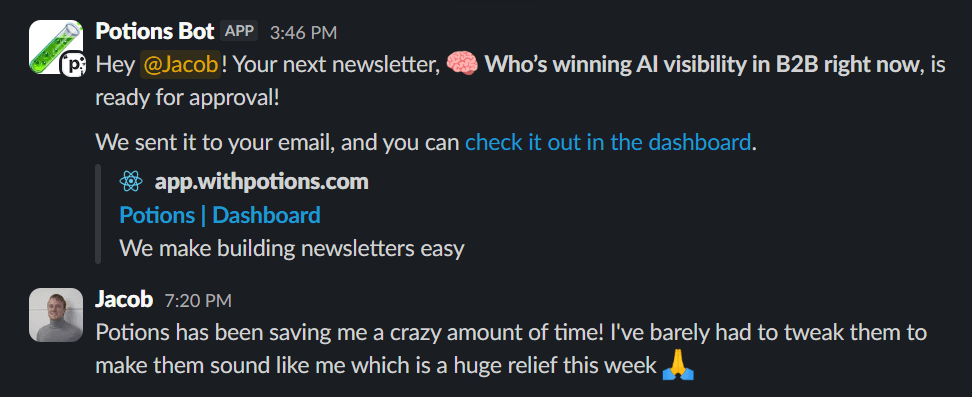
Potions also handles all the technical details behind the scenes to make sure every email follows best practices. This includes everything from sender setup, list cleaning, throttling, removing spam words, adding alt text, and more, so your emails land in the main inbox every send.
You'll even get monthly reports showing your warmest leads so you know precisely who to follow up with – perfect for B2B companies like Stat Digital that use their newsletter to turn leads into sales convos.
This hybrid of automation and human craftsmanship means you get high-quality newsletters at software-level pricing without adding more work to your calendar.
| Pros | Cons |
|---|---|
| Far cheaper than letting your business's lead list go cold and losing touch with them | Not for media companies that want to produce their own original content |
| All-in-one solution: platform + writing + design + deliverability | Not a fit if your newsletter is your main business and primary revenue driver |
| Consistent, high-quality newsletters written in your brand's voice | Not ideal for users seeking the cheapest or free newsletter option |
| Saves 80–95% of the time you'd spend doing it yourself | |
| Reports show your most engaged leads for easy sales follow-up | |
| Highly affordable alternative to hiring an agency or a team of freelancers (only starts at $129/month paid annually) | |
| Potions will help you choose and run the newsletter platform that fits your unique needs |
Key Features
- Done-for-you newsletter management – Potions writes, designs, & sends every newsletter.
- Hybrid platform & service – Combines the power of a modern newsletter platform with a full-service content & strategy team that's always available in your Slack workspace.
- Custom newsletter template – Your dedicated team builds a branded, reusable newsletter template aligned with your logo, colors, & tone of voice.
- Email optimization – Potions will optimize your emails to follow best practices (like adding alt text and removing spam words) and continuously improve each newsletter.
- AI-assisted content creation – Potions uses AI to interview you (or your team) & transform your insights into authentic, original newsletter content.
- Weekly newsletter drafts – Receive polished drafts for review & approval every week to maintain a consistent send cadence.
- Factual accuracy & on-brand checks – Every piece of content passes a 3-stage QA process for accuracy & alignment with your brand tone before being sent.
- Deliverability management – Potions handles sender setup, domain warm-up, list cleaning, & compliance so your emails land in the main inbox, not spam.
- Lead scoring reports – Get automatic reports of your most engaged subscribers so your sales or consulting team knows exactly who to follow up with.
- Monetization support – Potions can help you monetize your newsletter through ads, sponsorships, or paid subscriptions when you're ready to scale.
- Integrations & flexibility – Potions can run on your preferred platform (like beehiiv or Mailchimp) or host your newsletter directly on its own platform to simplify costs & workflows.
- List growth support – Add engaged subscribers for $2 per lead, or run managed growth campaigns under the Power plan.
Pricing
Potions offers flexible, affordable plans for weekly newsletters that scale with your audience.
The Starter plan starts at $129/month (paid annually) and offers custom banner and newsletter design. Higher tiers add features like lead enrichment, strategy calls, and managed list growth. Plans increase in price and features based on subscriber volume and growth needs.
Try out Potions with a free sample newsletter. Annual plans discounts are available.
💬 In their own words
"I've always wanted to add a daily send option to my newsletter but every time I attempted to push these out on my own I realized I was making my work week twice as long.
Since getting started with Potions I'm now sending 100% more mail (generating 200% more clicks), and my list loves the new daily content."

"I was spending 4-5+ hours weekly just to get one or two pieces of content out to reach my ICP. Potions changed that. They've empowered me to find my voice, and now I'm creating all my email and LinkedIn content in about 15 minutes a week! "

2. beehiiv: Best for Media Companies
beehiiv, founded by early Morning Brew employees, is built for creators and media brands that want to launch, grow, and monetize their newsletters under one roof.
beehiiv is most known for its growth tools and built-in monetization features like paid subscriptions, an ad network, and referral programs. But with most newsletters I've seen with email lists large enough to use the ad network, the revenue generated is usually just enough to cover your subscription costs.
The platform's deliverability is strong, and its analytics make it easy to understand which content performs best. However, beehiiv's fast growth has also led to growing pains, particularly around support and stability for users with smaller lists.

I've had success running multiple customers' newsletters on beehiiv, but it's not without its caveats. I know a ton of people who've been kicked off the platform because beehiiv flagged their lists as "cold." Although it's not malicious (beehiiv has to protect its domain reputation for its customer base), getting reinstated is extremely difficult, and the path to do it is pretty unclear.
To date, their AI writing assistant hasn't been helpful for us, and while they're rolling out API and integration features, those tools are still in the early stages, and HTML imports don't really work yet.
Overall, beehiiv works well for established newsletters that already have traction, but is less forgiving for new or smaller senders with existing lists.
Key Features
- 3D analytics (cohort analysis) – Track subscriber engagement and retention by cohort to identify which audience segments perform best over time.
- Referral program builder – Create built-in referral systems that reward readers for bringing in new subscribers, no 3rd-party tools required.
- Ad network & sponsorship marketplace – Matches newsletters with paid sponsors and ad placements directly inside beehiiv.
- Boosts marketplace – Enables cross-promotion between newsletters through paid or mutual referral placements to grow audiences faster.
- Monetization hub – Manage paid subscriptions, referrals, and sponsorships with no fees on revenue.
- Audience polls & custom forms – Collect reader feedback and insights directly inside newsletters or web archives.
- Web-hosted newsletter pages – Automatically publish newsletters to a public, SEO-friendly web archive for discoverability.
- Multi-newsletter management – Allows multiple newsletters or brands under one account with separate domains, lists, and analytics.
- Creator network – Connects publishers for cross-promotions, partnerships, and sponsorship opportunities within beehiiv's ecosystem.
| Pros | Cons |
|---|---|
| Built-in monetization tools (subscriptions, ads, and referrals) | Limited design flexibility, no true drag-and-drop editor (custom HTML is needed for advanced layouts) |
| Generous free plan for up to 2,500 subscribers | High risk of account suspension if lists are flagged as "cold"; the reinstatement process is unclear and difficult |
| Stellar deliverability infrastructure | Monetization features rarely produce meaningful revenue until ~50K+ engaged subscribers; even successful users often just break even with subscription costs, while degrading their content with ads |
| 3D Analytics for cohort tracking and audience insights | API and integration features are early-stage; HTML imports are unreliable |
| Fast-evolving platform with frequent feature releases | AI writing assistant performs inconsistently and lacks professional polish |
| Customer support responsiveness isn't great |
Pricing

beehiiv offers flexible plans, starting with the free plan (up to 2,500 subscribers), which allows unlimited sends, perfect if you're testing your first newsletter and want to write it all yourself. Paid plans start at $49/month, adding advanced automation, analytics, and monetization tools.
For large or media-focused newsletters, custom enterprise plans include dedicated support and full API access.
They offer a demo, 30-day free trial, and annual discounts.
In their own words

3. Substack: Best Free Newsletter Platform for Cultural Writing
Substack built its reputation as the home for independent writers, especially those publishing long-form essays, commentary, and cultural writing. Its minimalist interface makes it easy to write and publish newsletters or podcasts without worrying about the technical side of running a newsletter.

Writers can earn by charging subscribers for access to premium newsletters or podcasts, and Substack takes a 10% cut of that revenue. It's the platform that popularized the now-famous "1,000 true fans" model — if 1,000 readers pay $10 a month, you can make a living as an independent writer.
I live in New York, and I actually have a few friends that make a living on Substack through their "1,000 true fans". It sounds crazy, but it really does work (if you're a popular journalist or author).
Recently, Substack raised a 100M funding round and began positioning itself as a competitor to platforms like YouTube, expanding into video and social features. Their focus is less on email now, so it's unsurprising we're seeing poor performance from prospects and clients who use Substack.
Substack's original identity was "ad-free forever," but that's changing, too. The company has announced plans to introduce ads, a shift that marks a new era for the platform and could alter its long-held "cultural writer" vibe.
I used to run my own Substack in the early days, and we still manage a few for Potions customers. It's a great space for cultural writers who care about creating long-form cultural content, not sales funnels.
Compared to beehiiv's marketing-forward energy, Substack has a more editorial feel. It's more ideal for writers who really want to express their ideas on a platform with a social network element.
That said, it's not ideal for businesses running a newsletter for marketing purposes. Its analytics and customization are limited, and as Substack evolves toward social and video, it's becoming more of a media platform than a traditional newsletter tool.
TLDR; If you want to produce original research or thought piece content as an independent publisher, Substack is an excellent option. I probably wouldn't use it as a sales funnel though.
| Pros | Cons |
|---|---|
| Built-in discovery through recommendations and cross-promotion | Substack takes a 10% cut of paid subscription revenue (plus Stripe fees) |
| Simple, intuitive editor that feels like writing in a doc | Basic analytics compared to full-service marketing platforms |
| Free to use with unlimited subscribers | No automation tools to maintain deliverability or handle engagement sequences, which makes it not great for running a newsletter |
| Integrated podcast and video hosting | Cleaning your list is difficult, which can hurt your deliverability over time |
| No custom design features, making it challenging to differentiate your brand. |
Key Features
- Writer-first interface – Clean, distraction-free writing and publishing experience for essays, podcasts, and serialized content.
- Paid subscriptions – Ability to charge readers for premium newsletters or podcast access.
- Podcast hosting – Upload and distribute podcast episodes directly from your Substack dashboard.
- Video and social tools – New features that allow creators to post videos and engage followers beyond email.
- Community and comments – Built-in social layer for reader interaction and discussion.
- Native referral program – Rewards subscribers for bringing in new readers and ties directly into Substack's recommendation feed for organic audience growth.
Pricing
Substack is free to start and has no subscriber limits. You only pay once you enable paid subscriptions, where Substack takes a 10% platform fee, plus Stripe's standard processing fee (2.9% + $0.30 per transaction).
In their own words
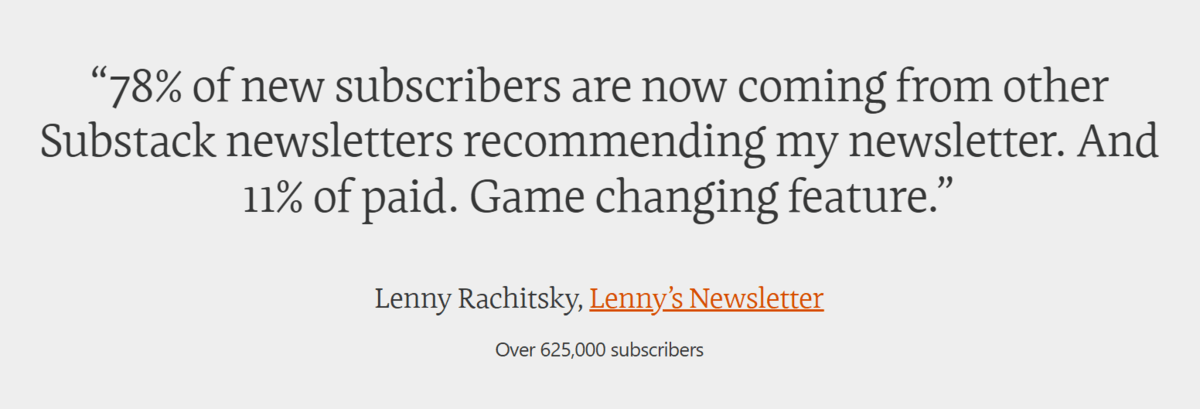
4. Medium: Best for Reader Experience (But on the Decline)
Medium is a clean, ad-free platform where you can publish essays, commentary, or thought pieces and reach a built-in audience of over 100 million readers. It's good for testing ideas, sharing expertise, and building visibility without managing an email list or website. Writers can join the Partner Program to earn modest revenue based on member reading time and engagement.

I personally use Medium and even joined the Partner Program, where I used to make a few hundred dollars per month from traffic, but those days are long gone. Which is why Medium has also been on the decline. High-quality writers used to flock to the platform for its earning potential, but now writers can only make a small fraction of what they used to, while the platform is flooded with low-quality, spammy content.
I found it helpful for experimenting with ideas. It's a great space to refine your writing or publish early thoughts before you have an established audience. But it's not where you build a business.
The platform limits your control over your readers and revenue. For example, they'll deprioritize your post if it's not paid, so you won't get as many eyeballs on your writing. Because of this, I treat it as a creative sandbox rather than a growth engine.
As for revenue, I earn about $40 a month from the paid ad network with 400 subscribers, which I'm fine with.
| Pros | Cons |
|---|---|
| Ad-free platform supported by reader memberships | No ownership of audience or data |
| Access to a large, built-in audience | Unstable algorithm and earning potential |
| Simple publishing tools and minimal setup | Not built for scaling a brand or business |
| Many quality writers have left the platform since earnings have declined |
Pricing
It's free to publish. To earn, you must join the Partner Program as a paid member ($5/month). The Friend of Medium tier ($15/month) directs more financial support to your favorite writers and the Medium platform.
In their own words
5. Kit: Dependable Option for Digital Sellers
Kit is a reliable, creator-focused email platform known for its simplicity and stability. It's especially popular among online educators, coaches, and creators who sell digital products, courses, or memberships. Kit offers high-level automation and tagging tools that help you deliver targeted messages based on subscriber behavior.
While it's not as flashy as newer platforms, Kit has a long track record and remains one of the most dependable options for creators who need automations that just work.
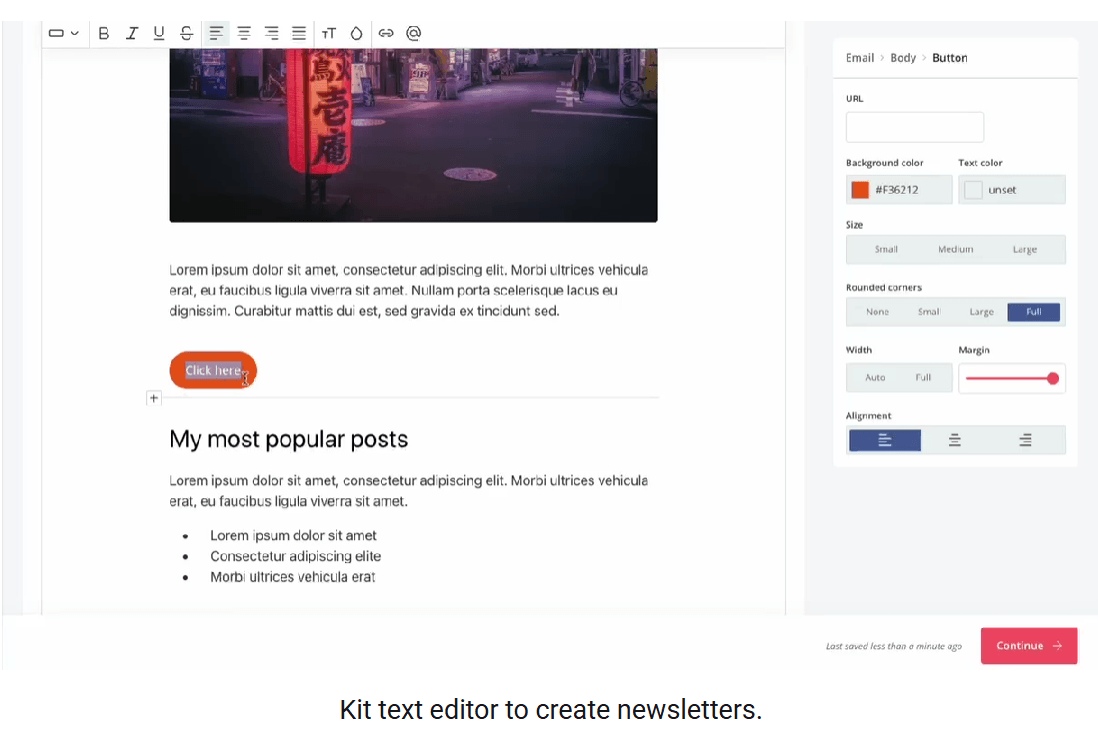
I've used Kit for multiple clients, and it's one of the more stable, affordable platforms out there. It's bootstrapped, not VC-funded, which means it's focused on sustainable growth. Kit integrates easily with Potions because their HTML importer works really well.
That said, we've fought with the tagging and segmentation system, as well as just adding subscribers to a newsletter list. When it comes to customization, changes don't get reflected quickly. The tech feels a bit dated, but it's consistent and rarely breaks, which I can't say for many tools in this space.
| Pros | Cons |
|---|---|
| Built-in tools for selling digital products, courses, and memberships | Doesn't support subdomains as sender addresses |
| Free plan for up to 10,000 subscribers | Limited design flexibility and a slow landing page editor |
| Strong deliverability (average 99.8%) and consistently high open rates | Lacks advanced analytics like click maps and geo-tracking |
| Bootstrapped and independently owned — no risk of sudden pivots like VC-backed platforms | Tagging and segmentation system can be confusing for new users |
| Really strong HTML importer |
Key Features
- Creator commerce tools – Sell digital products, courses, or memberships directly through email automations.
- Subscriber tagging and segmentation – Organize subscribers by behavior, interests, or purchase history for personalized campaigns.
- Visual automations builder – Design automated email flows using a clear, drag-and-drop interface.
- Customizable forms and landing pages – Capture leads through built-in templates (though the editor can be slow).
- Seamless HTML import – Custom HTML import function works well for newsletters.
- Reliable deliverability – Long-standing infrastructure with a strong sender reputation across major ESPs.
- 24/7 email & chat support – Access around-the-clock support for campaign, automation, and deliverability issues.
Pricing
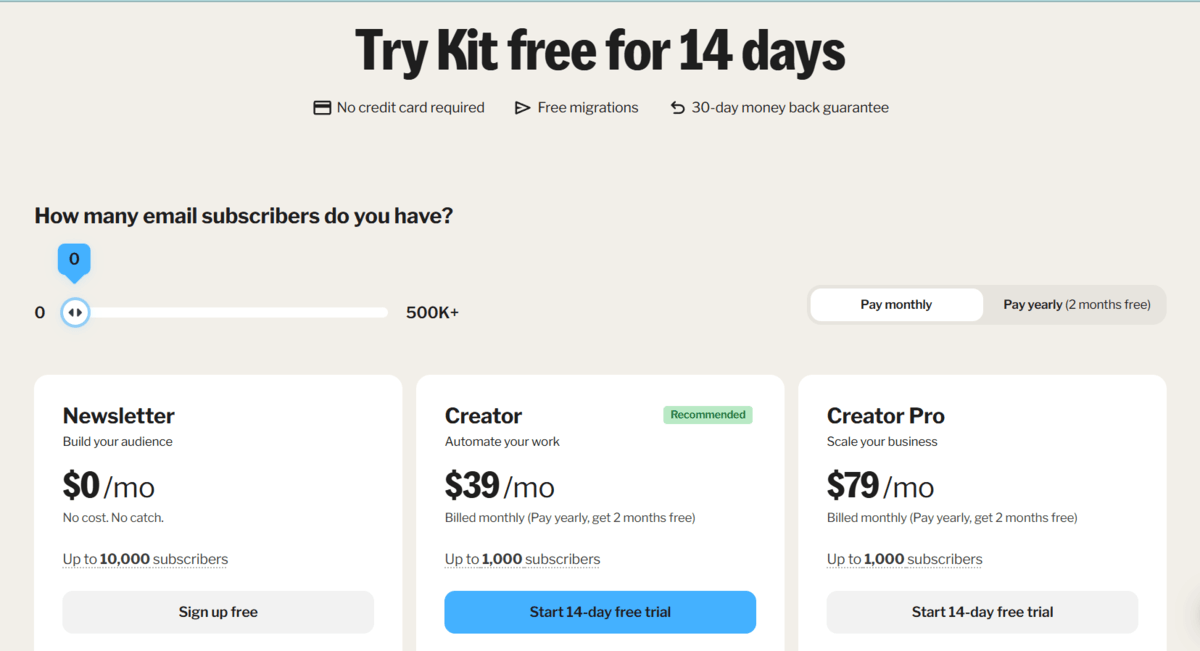
Kit offers a free plan for up to 10,000 subscribers, an unusually generous starting point. Paid plans start at $39/month and include advanced automations and sales features. The Creator Pro plan starts at $79/month and includes deeper insights, A/B testing, and premium support.
All plans include a 14-day free trial, annual discounts, and a 30-day money-back guarantee.
In their own words

6. MailerLite: Best for Affordability
MailerLite is a straightforward email platform built for creators, startups, and small businesses that want an affordable way to send clean, professional emails and newsletters. It's easy to learn, offers all the essentials for campaign management, and keeps the interface uncluttered.
While it's not as feature-rich as more advanced tools, MailerLite performs reliably for businesses that prefer to manage everything themselves. It's a good fit if you're hands-on with your marketing and just need a simple way to create, send, and track emails without overpaying for complexity.
I've seen MailerLite work well for smaller teams or customers who want to do everything manually. It's simple, affordable, and gets the job done, but it's severely limited in terms of customization, analytics, and automation depth. You won't get the sophistication of a platform like Kit or the growth tools of beehiiv, but for a lean budget or early-stage business, it's a great starting point.
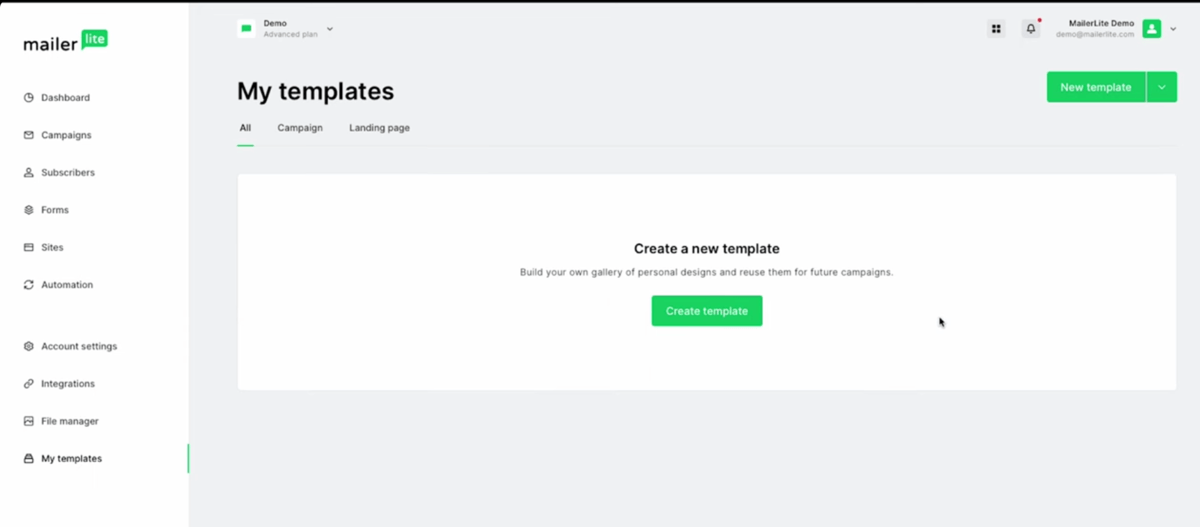
It's a solid contender for small businesses and solo marketers who need a reliable, budget-friendly email platform that still looks polished and performs well. You can personalize campaigns, run A/B tests, and sell digital products directly without touching code.
| Pros | Cons |
|---|---|
| Easy drag-and-drop editor with clean, modern templates | Limited CRM functionality and advanced segmentation |
| Affordable plans with transparent pricing | Not ideal for scaling or managing multiple complex newsletters |
| Excellent deliverability and responsive customer support (4.3 stars on Trustpilot out of 2.6k reviews) | Some features (like A/B testing and advanced automations) require paid plans |
| Simple e-commerce tools for selling digital products | Lacks deeper analytics and reporting for tracking subscriber engagement |
Key Features
- Clean, intuitive editor – Drag-and-drop interface designed for quick newsletter creation without technical setup.
- Landing page and form builder – Includes simple tools for collecting subscribers and promoting offers.
- Click maps – See where subscribers interact with links in your newsletter.
- Automation workflows – Supports basic email sequences, welcome flows, and time-based triggers.
- Audience segmentation – Create dynamic segments based on subscriber behavior, location, or engagement metrics.
- 24/7 customer support on paid plans – Responsive live chat support.
Pricing
MailerLite offers a free plan for up to 500 subscribers and 12,000 monthly emails.
Paid plans start at $10/month for up to 500 subscribers and unlimited emails. An Advanced plan (from $20/month) adds multivariate testing, enhanced reporting, and priority support.
All plans include a 14-day free trial and annual discounts.

In their own words
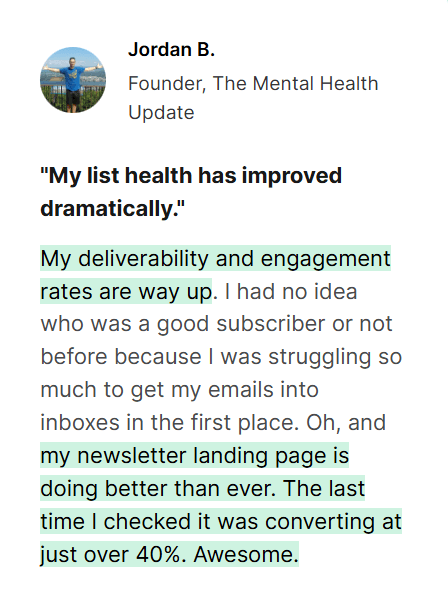
7. Constant Contact: Best for Non-Profits & Ticket Sellers
Constant Contact is one of the oldest email marketing platforms around. It's built for niche markets like ticket sellers and nonprofits that need an all-in-one tool to manage newsletters, announcements, and campaigns.
The platform combines email and SMS marketing, and social media posting tools under one roof. Its prebuilt templates, drag-and-drop editor, and automation options make it easy to send polished campaigns on a regular schedule.
For nonprofits, Constant Contact offers a 30% annual discount and specialized templates for donation drives, volunteer recruitment, and community events.
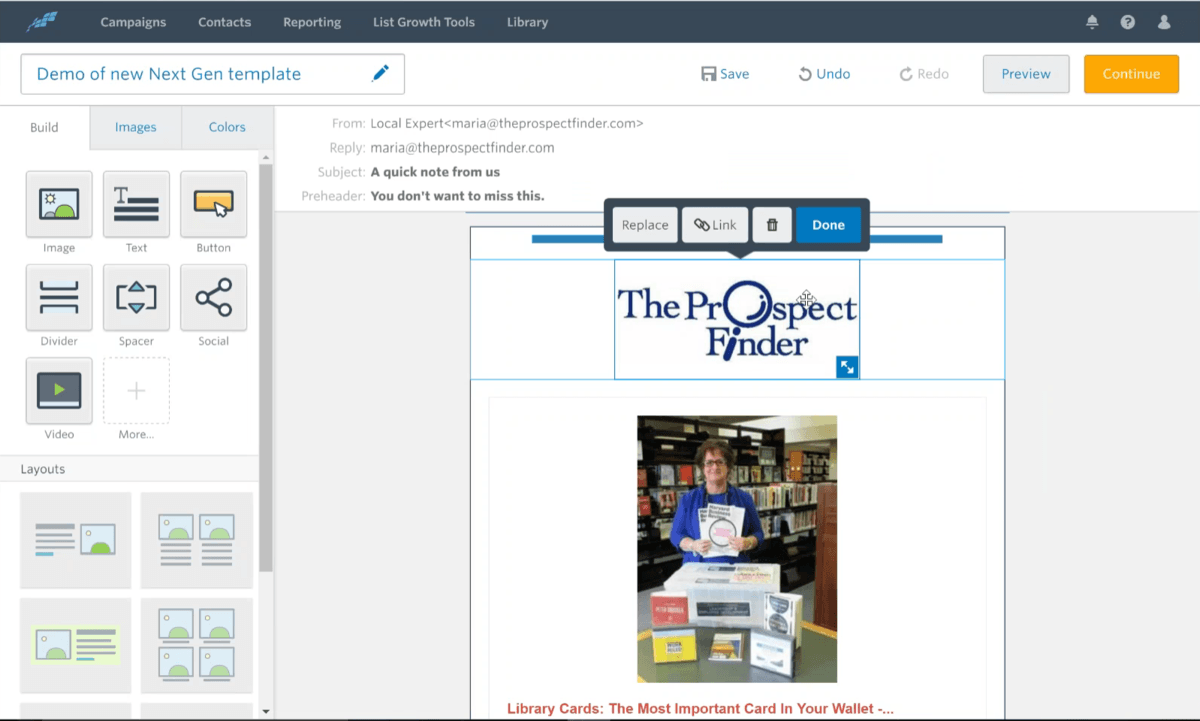
Constant Contact also offers unique features that cater to event-based businesses, such as the ability to create, promote, and manage tickets.
While it's reliable and supported by award-winning customer service, Constant Contact is best suited for teams that want to handle their own content and design.
Constant Contact's core business is its marketing platform, but they do offer a few done-for-you add-ons to help. From what I've heard, they're known to make customers lock in to plans with no easy way to leave without talking to support.
Although they have some add-ons, they're not known to be a creative or strategic partner. I see it as a solid, hands-on email platform — reliable, pretty user-friendly, and built to help you stay consistent, but not to guide your strategy.
| Pros | Cons |
|---|---|
| Extremely beginner-friendly and easy to set up | Template customization is limited compared to design-focused tools — pixel-perfect designs may require Canva or Figma |
| 100+ customizable templates and dynamic content blocks | Higher pricing tiers are needed to unlock advanced automation features |
| Built-in polls, forms, and surveys to boost audience engagement | A/B testing options are basic compared to enterprise platforms |
| Robust reporting and analytics dashboard | Can feel dated for users used to modern, minimalist ESPs |
| 300+ integrations with third-party tools like Shopify, Salesforce, and Canva | Not ideal for teams seeking a fully done-for-you or strategic content partner |
| Good choice if you sell tickets (like a concert venue) | Their DFY service at $535/month is far less affordable than Potions |
Key Features
- Event management tools – Manage RSVPs, ticket sales, and registration directly from your email campaigns.
- Social media management tools – Plan, create, and share multi-channel social media posts with one click.
- Donation and nonprofit templates – Prebuilt designs for fundraising, donor updates, and volunteer recruitment.
- SMS marketing – Send promotional texts, reminders, or event updates directly from your dashboard to support your email campaigns.
- List segmentation & tagging – Create segments & apply tags based on subscriber data or engagement activity.
- Marketing automation – Create welcome series, follow-ups, and drip sequences for new subscribers.
- 24/7 customer support – Live chat, email, and phone support for setup, troubleshooting, and campaign optimization.
Pricing
Constant Contact offers tiered pricing based on your contact list size.
Plans start at $12/month for up to 500 contacts and 5,000 emails, with higher tiers offering advanced automations and analytics, and full segmentation and reporting features.
All plans come with a free trial, and pricing scales with your contact list size. 30% annual discounts available for Nonprofits.
Done-for-you services that Constant Contact offers includes:
- A marketing advisor who reviews your campaigns for $60/month
- A marketing specialist who creates 3 campaigns from your content for $250/month
- A marketing manager who runs strategy, content, and reporting for $535/month
- Custom email design
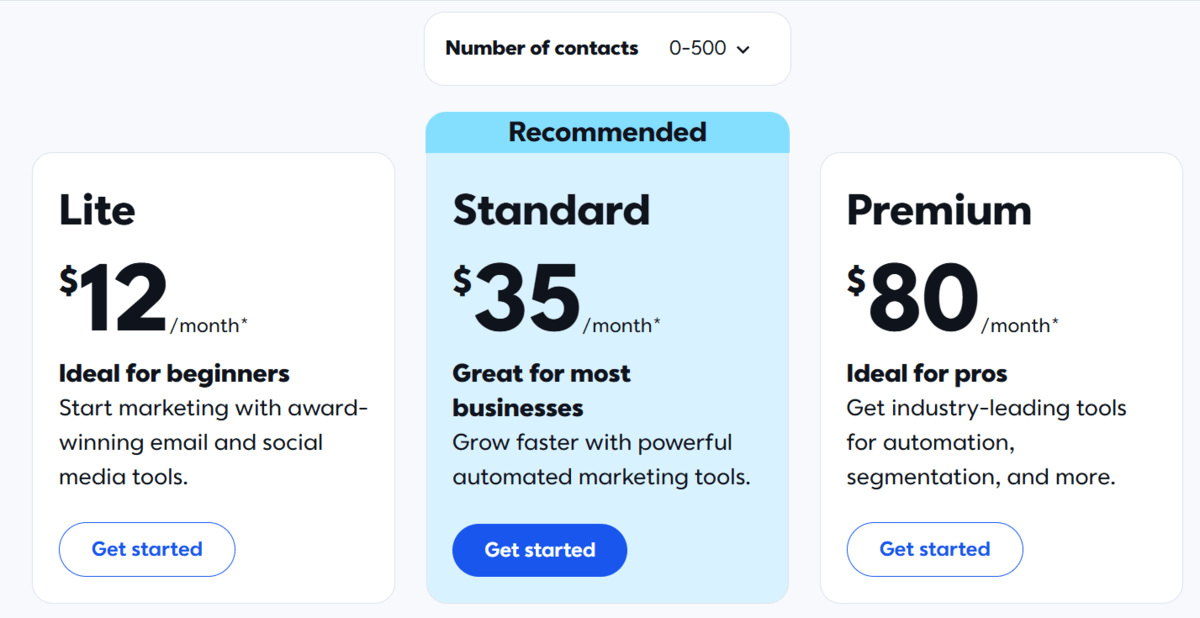
In their own words

8. HubSpot: Best for All-In-One CRM & Marketing Automation
HubSpot's Marketing Hub is a premium, enterprise-level all-in-one marketing platform designed for teams that need to connect every email, campaign, and customer touchpoint in one place. It's powerful but pricey, better suited to established businesses with complex workflows than to smaller teams sending newsletters.
The real advantage of HubSpot is its integration capabilities. Every email is connected to its built-in CRM, so you can see precisely how each newsletter contributes to leads, sales, and customer engagement.
Its automation tools, segmentation, and behavioral tracking are among the most advanced available. However, all that sophistication comes with a learning curve and significantly higher costs than most other newsletter platforms or services.
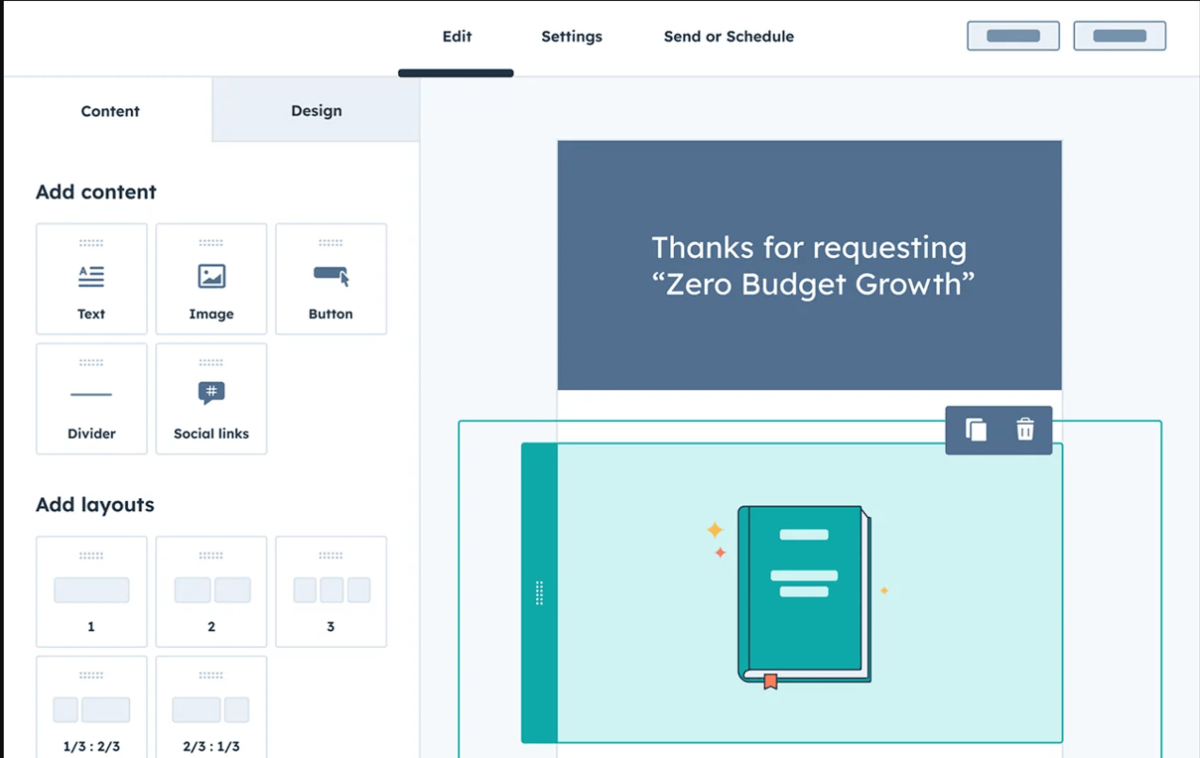
If you're willing to become so good at HubSpot that you can get a full-time job as someone who sets up and manages HubSpot for larger companies, then HubSpot can be great. But not so much, if you're looking for an intuitive tool that gives you the features you need without having to talk to sales and jump through hoops.
I've worked with clients who use HubSpot, and it's one of those platforms that can do everything, but you pay dearly for it. It's great for large companies that want sales and marketing perfectly aligned, but it's overkill for most small teams or consultants. I've seen many businesses sign up for the higher tiers and use only a fraction of the features, only to be stuck paying for all those bells and whistles. I've had friends pay for their expensive Marketing Professional plan ($800/month, paid annually) to unlock basic features, only to barely use it and switch to Mailchimp.
For our customers already running their business in Hubspot's CRM, Potions integrates seamlessly, allowing us to sync data, manage campaigns, and keep everything consistent between marketing and sales.
| Pros | Cons |
|---|---|
| Free plan includes a full-featured newsletter builder | Premium plans can be prohibitively expensive for smaller businesses |
| Deep CRM integration for personalized targeting and automation | Complex setup and steep learning curve for users new to CRM platforms |
| AI-powered tools for writing, design, and workflow automation | Onboarding fees apply to Professional and Enterprise tiers |
| Comprehensive reporting and revenue attribution tracking | Many businesses pay for advanced tiers but use only a fraction of the features |
| Seamless integration across marketing, sales, and service tools | Overkill for teams that only need a newsletter platform or service |
| Potions integrates directly with HubSpot for shared clients, ensuring seamless data sync and campaign management | Core features like Campaigns are locked behind the $800/month Marketing Professional plan and Sequences require Sales Hub at $90/month/seat (you'll need to pay or commit annually) |
| Complex pricing that takes time to understand | |
| You'll have to talk to sales where they'll try to upsell you |
Key Features
HubSpot's Marketing Hub includes a massive suite of marketing, sales, and automation tools, which contributes to its higher price point. Below are the features relevant to email and newsletter creation, automation, and performance tracking.
- Drag & drop email builder – Create branded newsletters using customizable content blocks within a visual editor.
- Email templates & personalization – Access prebuilt templates & use CRM data for personalized subject lines, greetings, or dynamic content.
- CRM integration – All email activity, sends, opens, and clicks, sync automatically to HubSpot's built-in CRM for unified tracking.
- Automation workflows – Set up drip sequences, behavioral triggers, or nurture campaigns through HubSpot's visual automation builder.
- Enterprise-grade extras – The Marketing Hub also includes tools for ads, chat, SEO, social, & website management, features that add power but come with a premium price tag.
Pricing
HubSpot offers a free plan that includes its basic newsletter builder, CRM, and limited automation tools. However, most advanced features, like robust automation workflows, detailed analytics, and higher contact limits, require a significant upgrade.
Paid plans start at $15/month/seat, but as you can see, the next tier quickly jumps into the high hundreds per month to unlock advanced capabilities.
Check out HubSpot's pricing page for full plan details. A free demo and annual discounts are also available.
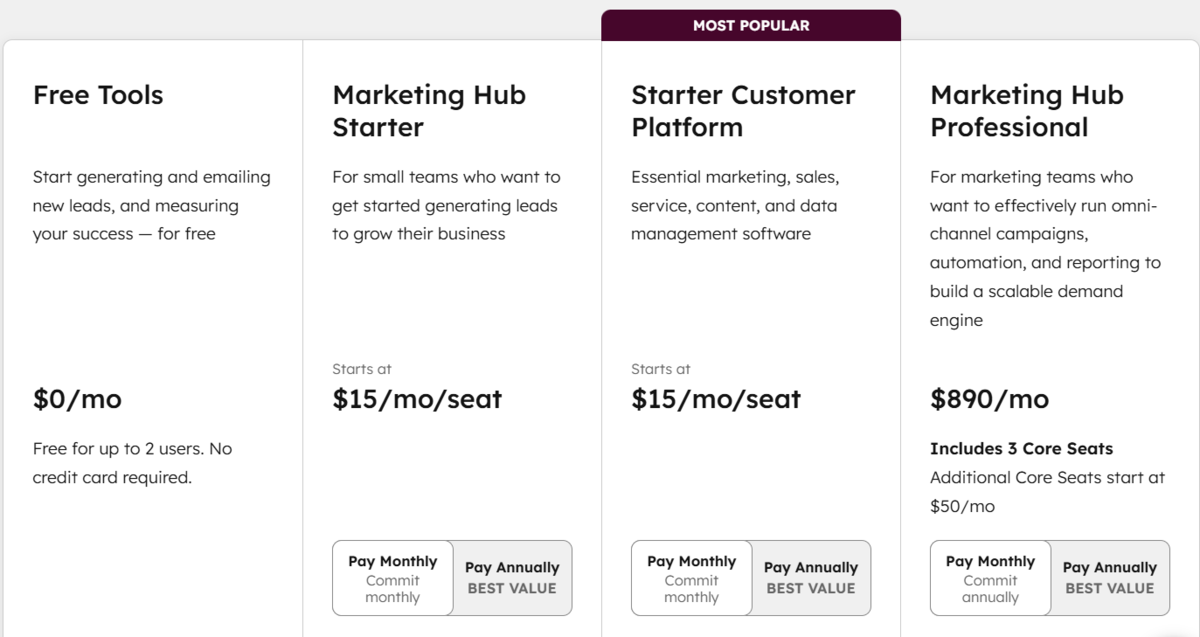
In their own words

9. Mailchimp: Most Recognizable
Mailchimp is one of the most recognized names in email marketing, initially known for its ease of use, robust automation, and broad feature set. It's often the first platform many businesses try. Mailchimp offers hundreds of templates, audience management tools, and built-in analytics.
That said, the platform has evolved over the years. Once known for its accessible pricing and small-business focus, Mailchimp is now positioning itself upmarket with more enterprise features and higher costs to match.
I've worked with several customers who started on Mailchimp, and it's still fine for small teams who want something recognizable and relatively easy to use.
But Mailchimp isn't as beginner-friendly as it used to be.
Critically, 67% of users rate its customer support 1 star. Plus, its pricing is increasingly difficult to justify for smaller senders.
For simple campaigns, it works. But if you want consistent deliverability and real help, there are better options now.
| Pros | Cons |
|---|---|
| Clean drag-and-drop editor with professional, modern templates | Advanced features are locked behind higher pricing tiers |
| Extensive automation and segmentation tools | Template customization is limited compared to dedicated design tools like Canva or Figma |
| Strong analytics, reporting, and A/B testing capabilities | Customer support has slow response times and isn't helpful |
| Integrates with 300+ apps and e-commerce platforms | Interface has become cluttered and less intuitive for beginners |
| Pricing has increased as Mailchimp moves upmarket, making it less SMB-friendly |
Key Features
- Creative Assistant (AI design tool) – Automatically generates on-brand graphics and templates from your uploaded assets.
- Journey Builder (automation) – Create complex customer journeys triggered by subscriber activity, purchase history, or engagement.
- Drag & drop editor – Create newsletters using a visual editor with customizable blocks for text, images, & buttons.
- Campaign benchmarking – Compare your newsletter's performance to other Mailchimp users in your industry.
- Click maps – Insight into which links and sections subscribers engage with most.
- E-commerce integrations – Native connections with Shopify, WooCommerce, Salesforce, and 300+ other tools.
Pricing
Mailchimp offers a basic free plan for up to 1,000 subscribers and 10,000 monthly emails.
Paid plans start at $13/month for 500 subscribers, adding advanced segmentation, A/B testing, and automation. The Standard plan starts at $20/month, while the Premium plan (from $350/month) unlocks advanced analytics, priority support, and unlimited audiences.
All plans include a 14-day free trial and 15% savings on annual plans.

In their own words
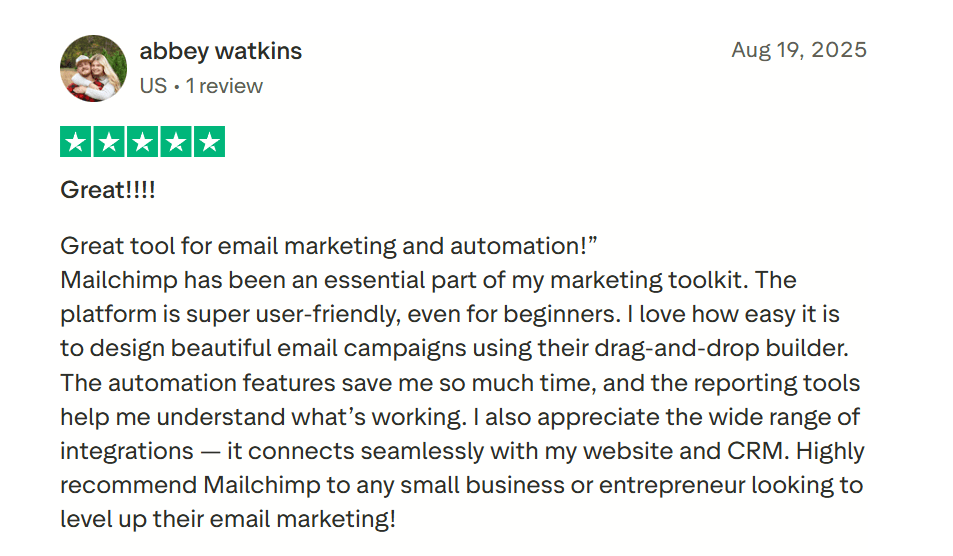
10. Moosend: Best for Affordable Marketing Automation
Moosend is a budget-friendly email platform that delivers a good amount of functionality for its price. It's designed for small businesses that want a straightforward way to create newsletters, manage contacts, and automate email workflows without committing to an expensive platform.
The interface is clean, and the drag-and-drop editor makes it easy to create professional campaigns quickly.

You get unlimited email sends on every plan, advanced automations even at entry-level pricing, and solid deliverability for the cost. While it lacks the polish and integrations of more premium tools, it's a reliable, low-cost option for teams who want to get started fast and don't need heavy analytics or deep CRM capabilities.
Moosend works well for small senders on a budget who just want something stable and straightforward, but if an email newsletter is one of your main marketing tools or you rely on advanced workflows, you'll outgrow it pretty quickly.
| Pros | Cons |
|---|---|
| Highly affordable pricing with access to advanced automation tools | Limited third-party integrations compared to larger platforms |
| Intuitive drag-and-drop editor with clean, professional templates | Smaller email template library than major competitors |
| Robust segmentation and behavioral targeting options | Customer support available only Monday–Friday |
| Excellent deliverability performance and responsive support team | Lacks deeper CRM and eCommerce integrations |
Key Features
- Drag & drop editor – Build newsletters using customizable content blocks with no coding required.
- Email template library – Choose from predesigned, mobile-responsive templates or create custom designs.
- Advanced segmentation – Filter subscribers by engagement, location, or custom fields to send targeted campaigns.
- Automation workflows – Design behavioral automations such as welcome emails, abandoned-cart reminders, or re-engagement sequences.
- Integrations & API access – Connect Moosend with CRMs, CMSs, and analytics tools for data synchronization.
- List cleaning & suppression tools – Identify inactive or invalid contacts and automatically remove them from active lists.
Pricing
Moosend offers flexible pricing starting at $9/month for up to 500 subscribers, with unlimited emails and access to all core features. Custom enterprise plans include dedicated IPs, priority support, and advanced integrations.
A 30-day free trial is available, and pay-as-you-go bundles are offered for occasional senders, along with annual plan discounts.

In their own words

11. Brevo: Best for Multichannel Marketing
Brevo is built for businesses that want to manage email, SMS, WhatsApp, and push notifications from one place. Known for its flexibility and affordability, Brevo combines a beginner-friendly newsletter editor with advanced automation, AI tools, and CRM integration to help you grow and engage your audience.
Brevo lets you combine email marketing with SMS, chat, and contact management in a single dashboard.
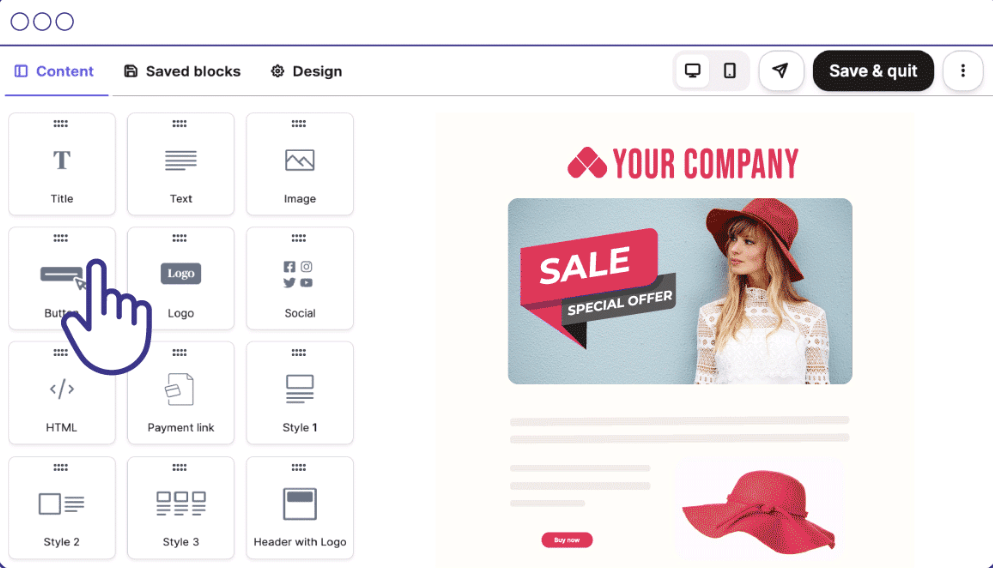
| Pros | Cons |
|---|---|
| Unified dashboard for managing email, SMS, and WhatsApp marketing | No live chat support available |
| Strong automation builder with advanced segmentation | Limited customization options on the free plan |
| Detailed real-time analytics, heatmaps, and performance dashboards | Steeper learning curve for first-time users |
| Some features (like CRM tools and dedicated IPs) are locked behind higher tiers |
Key Features
- Multichannel campaigns – Manage email, SMS, WhatsApp, and chat campaigns all from one platform.
- Drag & drop editor – Build newsletters using customizable design blocks in a visual interface.
- Transactional email API – Send order confirmations, password resets, or shipping notifications alongside marketing emails.
- Marketing automation builder – Design workflows that combine email, SMS, and CRM triggers for personalized sequences.
- Email heatmaps – See which links subscribers click on in your newsletter.
- Custom contact scoring – Rank leads based on behavior, engagement, and conversions to prioritize outreach.
- Unlimited contact storage – Store unlimited contacts and pay only for the number of emails sent, not list size.
- E-commerce integrations – Native connections with Shopify, WooCommerce, and Magento for abandoned-cart or product recommendation campaigns.
Pricing
Brevo offers a free, forever plan with up to 300 emails per day and unlimited contacts.
Paid plans start at $9/month for 5,000 emails and scale with sending volume. Higher tiers add advanced automations, A/B testing, and priority support.
Annual plan discounts are available.

In their own words

Agencies for Growing and Running Your Newsletter
Now, maybe you don't want another tool. You'd rather have a team, and you've got the budget to hire one.
These newsletter agencies do the heavy lifting, writing, designing, and/or growing your audience, so you can stay focused on your business.
12. The Feed Media: Best for Large Scale Newsletter Growth
The Feed Media is a high-performance growth agency built for large-scale newsletters that monetize through sponsorships, products, or B2B services. The Feed has helped major newsletters add millions of high-quality subscribers while keeping acquisition costs 20-30% lower than competitors.
They use their proprietary quality-to-cost framework to blend metrics like open rates, click-through rates, and engagement to find the most valuable audiences.
FYI, they work exclusively with large-scale newsletters and don't take on small or early-stage creators. Their clients typically operate in media, B2B, or large audience businesses looking to optimize for both subscriber growth and sponsor ROI.
They focus on growth and don't write or design newsletters. The Feed is a good fit for established teams that already have strong content and monetization models in place and want to grow them at scale. If your goal is to increase reach, expand sponsorship revenue, or improve acquisition efficiency, The Feed can help you do that.
Pricing
Working with The Feed Media is by application only. Projects are limited, and pricing is discussed after approval to ensure a strong fit and measurable ROI.
In their own words
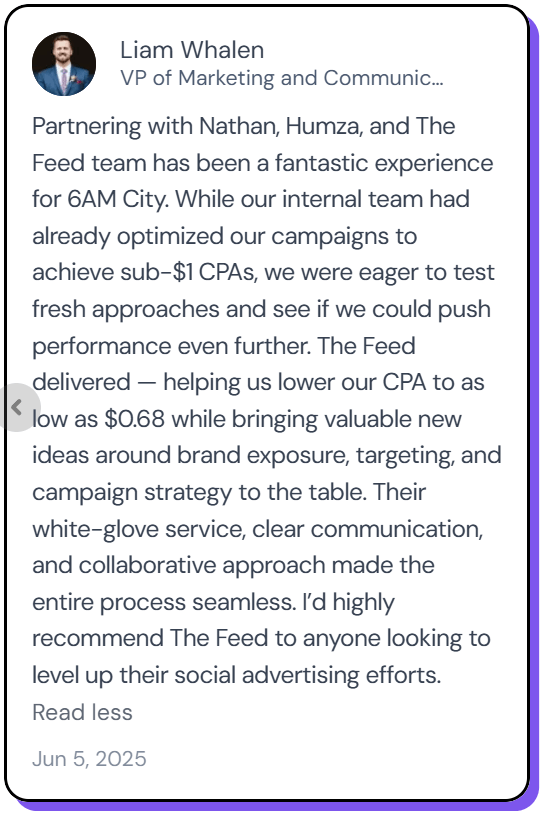
13. Thrive Letter: Best for Businesses That Want Both Growth & Newsletter Creation
Thrive Letter is a done-for-you premium newsletter agency and official beehiiv Partner that builds, designs, and manages profitable newsletters from end to end. They handle everything, from strategy and setup to writing, design, and reporting, so clients only spend about 30 minutes a week reviewing drafts.
The agency focuses on results-driven newsletters and is a good fit for beehiiv users who want and have the budget for a full-service partner to grow and monetize their newsletters without managing the process themselves.
Pricing
They've got 2 pricing plans: the Dedicated Done-For-You plan starts at $1,800 per month, while the Grow + Monetize customized plan adds sponsorships, SparkLoop integration, and lead magnet creation.
In their own words
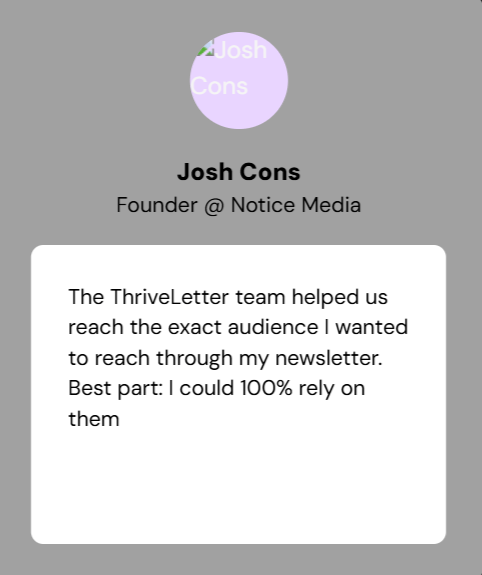
What to Consider in a Newsletter Service
Choosing the right newsletter service goes beyond finding the lowest price and the coolest templates.
You'll want to think about how much support you need, what technical setup is required, and how well the service helps your emails actually reach inboxes.
Another critical question: How much of an expert are you already in email marketing?
Choosing a platform and running the newsletter entirely yourself is fine if you're experienced and have the time.
Meanwhile, done-for-you options can handle setup, design, writing, and deliverability so you can stay focused on your business.
Here are 5 factors to consider before deciding on your platform or provider.
1. Technical setup & ease of use
Some newsletter platforms handle all the technical setup for you, while others expect you to configure DNS records, sender authentication, or custom domains yourself. If you're not tech-savvy, choose a service that makes onboarding simple or offers hands-on support.
2. Deliverability & sender reputation
Even the best newsletter won't make an impact if it lands in spam. Look for a provider with strong deliverability standards and proactive tools to protect sender reputation.
Some services maintain strict IP pool policies, while others offer dedicated IPs for high-volume senders. Choose a platform that gives you visibility into whether your content meets best practices for inbox placement and engagement.
Don't forget to ask if they make it easy to clean your email list to remove inactive subscribers.
3. Design flexibility & customization
People get a lot of emails.
While only ~9% of consumers say design has an impact on their trust with a brand, the reality is that design plays a make or break role in your email's performance.
Some quick, critical stats from Nonprofit Tech:
- 53% of email is opened on mobile—and emails not optimized for mobile get deleted in under 3 seconds, with 15% of users unsubscribing.
- Emails with graphics see a 1.12% higher CTR, and adding video can boost clicks by 65%. This is signficant,as CTR is typically around 2% - 2.9%.
Your newsletter should reflect your brand, not look like a cookie-cutter template. Make sure the platform lets you customize layouts, colors, fonts, and sections without needing to code. Advanced tools often include drag-and-drop editors, reusable content blocks, and mobile previews so your design looks great on any device.
If design isn't your strength, consider a provider that includes professional design support or prebuilt branded templates.
Finally, remember to test your email design for accessibility guidelines using a tool like Litmus (or just let Potions do it for you). If you don't, your deliverability will take a hit.
4. Scalability & pricing
Your newsletter service should grow with you. Check out how pricing scales as your subscriber list expands because some charge per subscriber, while others bill by the number of emails you send.
Check for hidden costs or overage fees when you pass certain thresholds. And ask whether the service includes automation and advanced analytics at lower tiers or only at premium levels.
If you're outsourcing your newsletter entirely, make sure the pricing aligns with the value you're getting. Some done-for-you services include everything from strategy to content creation, while others just handle production.
5. Support & subscriber growth tools
A lot of email platforms are simply too cheap to have human support.
Good customer support can save hours of frustration, especially when you're managing deliverability or automation. So look for platforms that provide live chat or dedicated account management rather than just an automated help center.
Newsletters are almost never "organically viral". Only 0.5% - 2% of people will forward any of your emails*.
So, consider whether the service helps you grow your email list through your "top of funnel" channels. Features like signup forms, lead magnets, referral programs, and integrations with CRMs or social platforms can make list building much easier and faster.
*This doesn't mean email isn't great for growth; it's just not a "top of funnel" action, like ads.
Frequently Asked Questions
What are the Best Free Newsletter Services?
If you're just getting started, some of the best free newsletter services include beehiiv, Substack, and MailerLite. Each offers a free plan with basic tools for sending and growing your newsletter. Keep in mind, free plans usually limit how many subscribers or emails you can send, so they're best for testing the waters before you scale.
How Much Does it Cost to Run a Newsletter?
The cost of running a newsletter depends on how hands-on you want to be. Most DIY newsletter platforms range from $10 to $200 per month, depending on your subscriber count and feature needs. Or a done-for-you service usually costs more ($1800+). A hybrid solution, like Potions, blends automation with human expertise for a much lower monthly cost.
Most DIY newsletter platforms range from $10 to $200 per month... Potions, blends automation with human expertise starting at $199/mo.
How Much Time Does it Take to Run a Newsletter?
If you're writing and designing it yourself, plan for 3-7 hours per week to brainstorm topics, create content, design, test, and send. That doesn't include tracking performance or making improvements.
Done-for-you newsletter services cut that time down to about 15-90 minutes a week, since you only need to review and approve content. But even with a DFY service, no one can read your mind, so expect to spend at least 15 minutes per week.
The more soul you put in, the better the results, but just some — even if it's not the greatest — is better than nothing.
Plan for 3-7 hours per week to brainstorm topics, create content, design, test, and send.
No More Excuses: Pick a Tool — Start Your Newsletter
Newsletters remain one of the most effective ways to nurture leads, build trust, and stay top of mind. But only if you send them out consistently. Whether you prefer full control with a DIY platform or want a partner to handle everything, the right newsletter service can transform how your business communicates.
If you're ready to stop juggling content, design, and deliverability, and start sending newsletters that actually drive results without breaking the bank, Potions delivers.
👉 Get your free sample newsletter from Potions. Can you imagine the peace of mind that comes from a consistent, high-performing newsletter that runs on autopilot?
